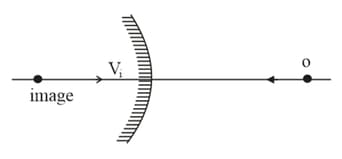In the figure shown a point object is placed in the air on the principal axis. The radius of curvature of the spherical surface is . If is the final image formed after all the refractions and reflections.



Important Questions on Ray Optics
A particle is moving towards a fixed convex mirror. The image also moves. If speed of image and speed of the object, then

A parallel beam of light is incident normally on the flat surface of a hemisphere of radius and refractive index , placed in the air as shown in the figure . Assume paraxial ray approximation.

A ray is an incident on a refracting surface of refractive index at an angle of incidence and the corresponding angle of refraction is . The deviation of the ray after refraction is given by . Then, one may conclude that
A convex lens and concave lens are kept in contact and the combination is used for the formation of the image of a body by keeping it at different places on the principal axis. The image formed by this combination of lenses can be
A ray of light travelling in water is incident on its surface open to air. The angle of incidence is , which is less than the critical angle. Then, there will be
